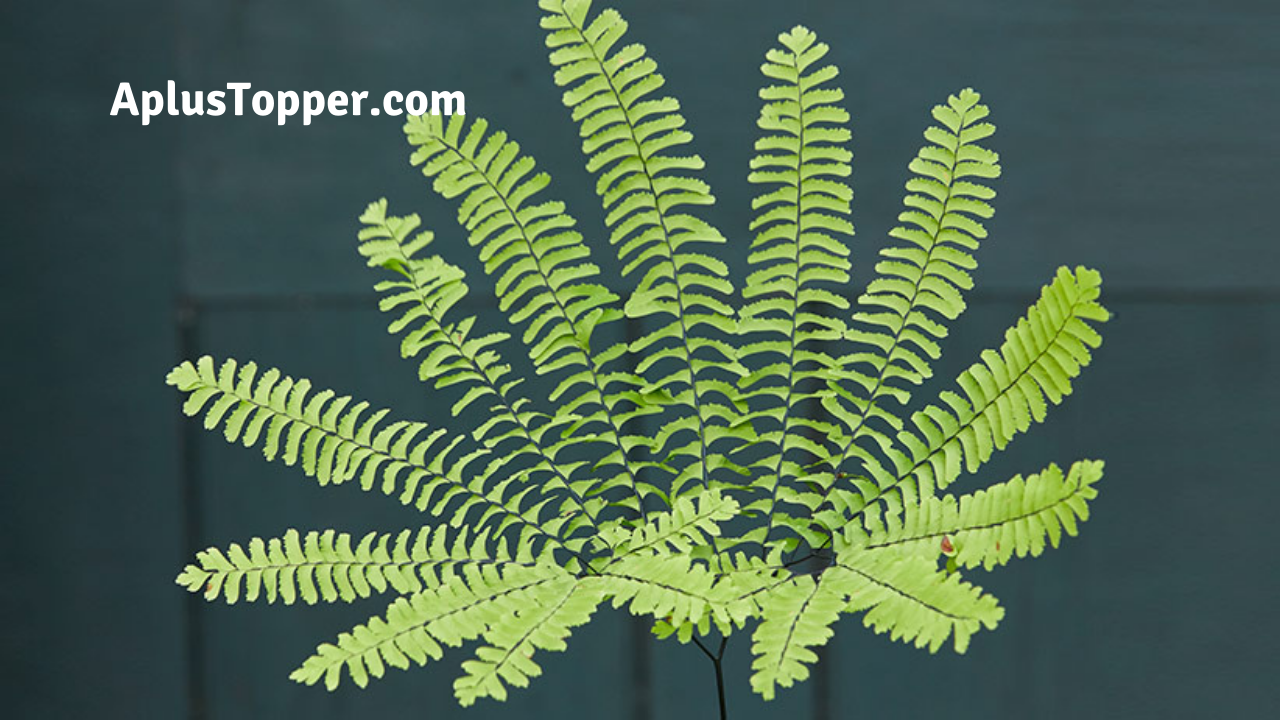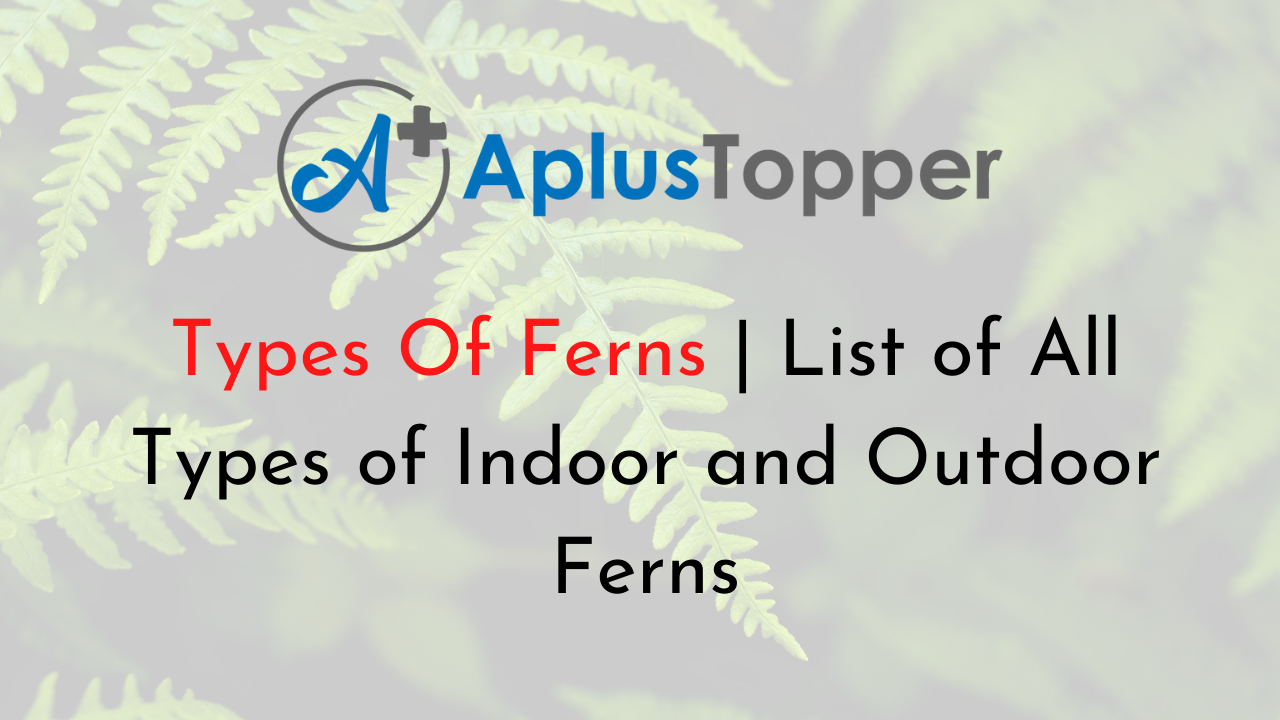Types Of Ferns: Ferns are a member of vascular plants that are one of the oldest plants on earth with their history dating back to the Devonian period, 360 million years ago. Even the ferns that we see today, some of them date back 145 million years.
There are more than 10000 species of ferns and they all vary in sizes from 2 millimeters to 25 meters. Depending upon the species, some of the ferns can have a lifespan of 100 years. Ferns do not have flowers or seeds and their reproduction of a fern happens with their spores.
With a lush green appearance and their tendency to thrive in low light areas, they are a popular choice for dark corners of your home and garden. While they are native to tropical areas, you can grow them in your garden with little care. Ferns don’t really need extensive care, all you need to provide them is the right environment.
Develop Verbal Skills among kids by exploring more Picture Dictionary Ideas through the visual techniques and interactive approaches used.
Ferns have a specific set of names for their parts and let’s understand them before moving on to the types of ferns.
The rhizome is the part of the fern which produces roots to take water and nutrients from the soil. The stalk is the part responsible for offering support and is the part that connects the root to the leafy part of the plant. The blade is the whole leaf part of the firm. The blade and stalk part are combinedly known as a frond. An uncurling frond is known as a fiddlehead.
There is a vast variety of ferns but you can classify them into two distinct kinds. One that you can grow inside and the other that thrives outside. Let’s have a look at some of them.
Ferns Types
Indoor Ferns
Rabbit’s Foot Fern
This is one of the unique-looking ferns that is very popular as an indoor plant. The name rabbit foot is because the rhizomes in this plant have a hairy fuzzy appearance that resembles a rabbit’s foot and the rhizomes will grow out of the soil and the container which makes it look even more attractive.
This fern has a slow growth but has a long life. While it can survive outdoors if the area where you place it is properly shaded, it thrives indoors in a brightly lit area. Hanging baskets are the best way to grow a Rabbit’s foot fern with the rhizomes hanging outside.
This plant needs well-drained soil and moderate watering.
Evergreen Fern
Ferns like any other plant shed leaves or die when the season starts to change. But to our relief, there are a lot of evergreen fern varieties that will thrive even during the fall and winter seasons. While choosing an evergreen fern for your home make sure that you select one native to your region.
Evergreen ferns are diverse and can range from small to huge in size. While large evergreen ferns are good for outdoor gardens to offer some sense of greenery in the middle of a frost, some small and delicate varieties thrive better when kept indoors. Make sure to place them in a humid area like your bathroom.
Christmas fern, American Hart’s tongue fern and Hairy lip fern are some evergreen ferns that you can choose to grow indoors.
Blue Star Fern
Blue star fern is a variety of fern that is easy to grow indoors. If you are new to growing ferns, then this is the variety to try. The name blue star is due to the bluish-green color of the leaves. It doesn’t require much care and the added bonus is that it is a good-looking plant. It doesn’t need as much humidity as other ferns and can survive a drier environment.
Another main reason why this is such a good choice for indoor ferns is the size of the plant is relatively small. Although a Blue star fern can grow up to 2 feet in height when planted into the ground. Planting it into a container limits its growth and spread.
One thing that you need to keep in mind while watering a blue star fern is that the soil in the container should be moist and not damp.
Grey Ghost Lady Fern
Another good-looking fern is the Grey ghost lady fern. It got its unique name from the silvery-white color of its leaves and the purplish midribs enhance the beauty of the leaves even more. It is more tolerant to dry environments than most other ferns. It is also relatively easy to grow and doesn’t need much care.
It grows well in the shady areas of the garden but you can also keep it inside in a humid area. The soil in the container should be well-drained and moist.
Boston Fern
Boston fern is the most common type of fern that you will find in homes. It can grow about a meter tall and its leaves trail down the container. It is great for hanging in a place that gets indirect sunlight. This plant can not tolerate a dry environment and you would need to mist the plant every few days in the winter season.
Another thing to keep in mind is that this plant does not need fertilizers as the plant is highly sensitive and might die. Keep the soil moist and for better humidity, you can also hang this plant in your bathroom.
Cretan Brake Fern
This is one of the prettiest-looking ferns that is really popular as a houseplant. The leaves of this plant have two different shades of green and the shape of the leaves are unique. The leaves grow on long fronds and have a light green stripe in the middle with the edges being darker in shade.
This fern is very easy to grow and doesn’t need much maintenance. You can grow it indoors or outdoors if you live in an area with hot climate conditions.

Outdoor Ferns
Osmunda Fern
These ferns are native to America and found in abundance. They can grow on their own on the riverbanks as they thrive in swamp-like conditions. If you have a corner in your garden that doesn’t get much sunlight, then this Osmunda fern would be ideal as they grow really tall and can fill up a space beautifully.
When planting this fern at your home, make sure to water it thoroughly as it can survive in less water. There are several varieties of Osmunda ferns.
Osmunda Regalis or Royal fern grows tall at five feet and is best suitable for outdoors.
Osmunda Cinnamomea or Cinnamon fern is another type of Osmunda fern which can reach a height of up to six feet. It is better to plant it in partial or full shade but it can survive long hours in the sun as long as it is planted in water.
Osmunda Claytoniana or Interrupted fern takes up a lot of space in your garden with it being 6 feet wide. The name interrupted is because of the brown leaves that interrupt the green leaves. This fern shades its leaves in the fall which might make your garden look empty.
Ostrich Fern
As it is clear from the name, this is a variety of fern which grows really tall. A full grown ostrich fern can reach up to five feet in height.
The name ostrich is due to the leaves of these ferns which have a resemblance to ostrich’s tail. One unique feature these ferns have is that the leaves are broader at the top and narrow down gradually toward the bottom.
Direct sunlight is not suitable for ostrich ferns and the plant should be in partial shade. The soil should be moist and since the plants are tall, protection against harsh winds is also necessary.
Asparagus Fern
This is one of the unique varieties of fern, given the fact that it bears flowers and fruits sometimes. The leaves of this fern look fuzzy and soft but have little thorns in them.
One unique feature that this fern has is that when the plant is at its healthiest, it will bear red berries which look so good with the bright green contrast leaves.
These ferns can grow quite a lot, it is always better to prune them at regular intervals.
You can grow these plants indoors as well as outdoors, but they thrive well in outdoor gardens. However, when the weather gets too cold and dry, you would need to bring these ferns inside if you have them in a container.
Japanese Painted Fern
This is another one of the prettiest-looking ferns. The fronds on this fern have a blue-silver color and a red stem which makes them different from the regular lush green ferns. The unique color of this fern makes it so appealing.
Another reason why these are so popular is that they can withstand harsh cold weather. However, the soil quality is something you can not compromise on if you are planting this fern in your garden. The soil must be rich in nutrients and the plant needs regular fertilizing.
Bird’s Nest Fern
The middle of this fern has a resemblance to a bird’s nest which is why it is named as such. The leaves on this fern are wide and so different from other ferns. With its small size, it is ideal for gardens.
However, the plant needs shade and moist soil for better growth. One other thing that makes it different is the fact that when exposed to sunlight, the leaves of this plant will crinkle.
Conclusion on Types Of Ferns
Ferns have over 10000 species, and we haven’t even covered the tip of it. There is a fern for every need and size. Ferns are great as a houseplant. Not only are these plants easy to care for but some of them can also survive harsh winters.
